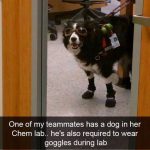Dog etiquette is important no matter where you live, but in urban areas, it’s even more critical. People with dogs in the city are challenged when out with their dogs. That requires a keen sense of your surroundings, other dogs and other people, at all times. While many trainers teach dogs to walk on the owner’s left side at the heel, city dogs learn early that there are lots of goodies on the sidewalk. It’s encouraged that if you’re walking your dog in the city, walk your dogs a little in front of yourself so that you can see if your dog is nibbling something from off of the street — chicken bones, rat poison, wrappers and more can all be tasty treats that you don’t want your dog to have. You should encourage your dog to do his important business at the very edge of the sidewalk preferably in the grassy areas and you should always pick it up. Realize that not all dogs are friendly and that you should ask the owner of the other dog if it’s okay for your dogs to interact. Lastly, make sure your dog knows to stay close to you and obeys your commands when walking.
Puppy Food
A growing puppy is like a small child, they are a bundle of endless energy. That is why it is important that they receive all the right nutrients in their diet to help aid them throughout their growing process. It can be hard to find a good balance for your dog, and whether or not you have chosen the right brand to suit your dog’s nutritional needs. Choosing the right dog food doesn’t have to be hard, and we are going to help you narrow down the best puppy food for a growing pupper and everything you need to know about your dog’s diet. The best puppy food plays a vital role in the overall development of your dog. Your puppy is a bundle of energy, it’s important that they have a meal that is high in calories and dense in nutrients, as this is the type of food that will give your pup the boost they need during those first few crucial years of development. The five main ingredients that are recommended for young dogs are proteins, minerals, fats, oils, vitamins, and carbohydrates. It can be hard to choose which puppy food is right for your dog so I recommend that you do all your necessary research on your dog’s breed and the food you’re planning on buying for that breed.
Training
The first question you should ask yourself when you get a new dog is when should you start training your new puppy. You will be training your puppy from the moment you bring it home and start to house train. Puppies start learning from birth and good breeders begin handling and socialization right away. Some training can begin as soon as the puppy can open its eyes and walk. Young puppies have short attention spans but you can expect them to begin to learn simple obedience commands such as “sit,” “down,” and “stay,” as young as 7 to 8 weeks of age. Formal dog training has traditionally been delayed until 6 months of age. Actually, this juvenile stage is a very poor time to start. The dog is learning from every experience and delaying training means missed opportunities for the dog to learn how you would like him to behave. During the juvenile stage, the dog is beginning to solidify adult behavioral patterns and it’s hard to undo all of those patterns. Behaviors learned in puppyhood may need to be changed. In addition, anything that has already been learned or trained incorrectly will need to be undone and re-taught. Puppies are capable of learning much from an early age so it’s best to start as young as possible. You can’t teach an old dog new tricks.
Where did dogs come from?
Dogs have a very interesting history because of the fact that they basically were domesticated by humans and created from wolves through selective breeding. Humans used to live in fear of other hungry creatures but were good hunters so they were able to take care of themselves. Humans used to eat all of the meat off the animals they hunted but left the bones. Wolves tried to scavenge the bones to feed, but most of them were too frightened to come close enough without causing alert. Their fear is due to high levels of stress hormones in their blood. For them, it’s a matter of survival because they know coming too close to humans can be fatal. However, a few wolves, due to natural variations, had lower levels of those hormones that made them less afraid of humans. Around 15,000 years ago, wolves discovered an excellent survival strategy; the domestication of humans. They let the humans do the hunting, didn’t threaten them, and humans let them scavenge their garbage. The wolves ate more regularly, had more offspring, and those offsprings inherited their disposition. This selection for tameness would be reinforced with each generation until that line of wild wolves evolves into the loyal dogs we have today. Man’s best friend.
Laughs

Picking Your New Best Friend
When you get your first dog, it’s always a tough choice. There are so many choices to pick from and you should realistically start from what you’re looking for in a dog. My first suggestion is that you’re probably better off not getting a purebred dog. By definition, a purebred dog typically refers to breed that is selectively bred only with dogs of its own breed, resulting in them sometimes breeding with their own relatives which can cause a lot of genetic diseases in the long run. Instead of getting a purebred, you should consider getting a mutt. Mutts are dogs in their natural state. Even though humans have lived with domesticated dogs for over ten thousand years, purebred dogs didn’t even exist until about a hundred and fifty years ago. It’s honestly kind of cruel what has been done with all of these purebred dogs. Humans like to play god with them and shape them into whatever we deem fit and it’s starting to become a problem. Statistically, 60% of Golden Retrievers die of cancer because of all of the genetic diseases caused by generations of inbreeding. Breeds like the bulldog are one of the best examples of selective breeding gone wrong. Their noses are so squashed that they can barely breathe. Their heads are so big that they almost always have to be born via C-section. Their tails can become ingrown, they basically all have hip dysplasia, and their average life expectancy is only six years. Being alive for these dogs is a form of suffering. If you want the best for your dog and your family, get a dog that has mixed breeds as that’s usually the healthiest dogs.
“Evolution of the Dog.” PBS.org. Public Broadcasting Station, 2001. Web.
Beck, Melinda. “When Cancer Comes With a Pedigree.” Wall Street Journal. Dow Jones & Company, 4 May 2010. Web.
Denizet-Lewis, Benoit. “Can the Bulldog Be Saved?” New York Times Magazine. The New York Times Company, 22 Nov. 2011. Web

















